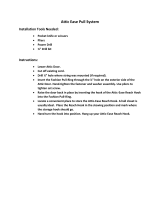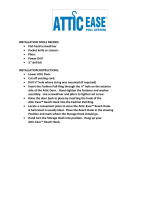
4
102392
NATURAL GAS HEATER
BLUE FLAME 10,000 BTU
WARNING: If the area in which
the heater may be operated is
smaller than that defined as an
unconfined space, provide ad-
equate combustion and ventila-
tion air by one of the methods
described in the
National Fuel
Gas Code, ANSI Z223.1, 1992,
Section 5.3 or applicable local
codes.
AIR FOR
COMBUSTION AND
VENTILATION
Continued
Continued
Unusually Tight Construction
The air that leaks around doors and win-
dows may provide enough fresh air for
combustion and ventilation. However, in
buildings of unusually tight construction,
you must provide additional fresh air.
Unusually tight construction is
defined as construction where:
a. walls and ceilings exposed to
the outside atmosphere have
a continuous water vapor
retarder with a rating of one
perm (6x10
-11
kg per pa-sec-
m
2
) or less with openings
gasketed or sealed
and
b. weather stripping has been
added on openable windows
and doors
and
c. caulking or sealants are ap-
plied to areas such as joints
around window and door
frames, between sole plates
and floors, between wall-ceil-
ing joints, between wall pan-
els, at penetrations for plumb-
ing, electrical, and gas lines,
and at other openings.
If your home meets all of the three
criteria above, you must provide
additional fresh air. See
Ventilation
Air From Outdoors
, page 5
.
If your home does not meet all of
the three criteria above, proceed to
Determining Fresh-Air flow For
Heater Location.
Confined and Unconfined Space
The National Fuel Gas Code (ANSIZ2123.1,
1992 Section 5.3) defines a confined space
as a space whose volume is less than 50
cubic feet per 1,000 Btu per hour (4.8 m3 per
kw) of the aggregate input rating of all
appliances installed in that space and an
unconfined space as a space whose volume
is not less than 50 cubic feet per 1,000 Btu
per hour (4.8 m3 per kw) of the aggregate
input rating of all appliances installed in that
space. Rooms communicating directly with
the space in which the appliances are in-
stalled*, through openings not furnished
with doors, are considered a part of the
unconfined space.
* Adjoining rooms are communicating only
if there are doorless passageways or ventila-
tion grills between them.
DETERMINING FRESH-AIR
FLOW FOR HEATER
LOCATION
Determining if You Have a
Confined or Unconfined Space
Use this worksheet to determine if you have
a confined or unconfined space.
Space: Includes the room in which you
will install heater plus any adjoining rooms
with doorless passageways or ventilation
grills between the rooms.
1. Determine the volume of the space
(length x width x height).
Length x Width x Height =
______ cu. ft. (volume of space)
Example:
Space size
18 ft. (length) x 16 ft. (width) x 8 ft.
(ceiling height) =
2304 cu. ft. (volume of space)
If additional ventilation to adjoining
room is supplied with grills or open-
ings, add the volume of these rooms to
the total volume of the space.
2. Divide the space volume by 50 cubic
feet to determine the maximum Btu/
Hr the space can support.
_____ (volume of space) ÷ 50 cu. ft. =
(Maximum Btu/Hr the space can sup-
port)
Example:
2304 cu. ft. (volume of
space) ÷ 50 cu. ft. = 46.1 or 46,100
(maximum Btu/Hr the space can sup-
port)
3. Add the Btu/Hr of all fuel burning ap-
pliances in the space.
Vent-free heater _________ Btu/Hr
Gas water heater*________ Btu/Hr
Gas furnace ____________ Btu/Hr
Vented gas heater ________ Btu/Hr
Gas fireplace logs________ Btu/Hr
Other gas
appliances* + ___________ Btu/Hr
Total = ________________ Btu/Hr
Example:
Gas water heater
40,000 Btu/Hr
Vent-free heater + 10,000 Btu/Hr
Total = 50,000 Btu/Hr
* Do not include direct-vent gas appli-
ances. Direct-vent draws combustion
air from the outdoors and vents to the
outdoors.
4. Compare the maximum Btu/Hr the
space can support with the actual
amount of Btu/Hr used.
__________ Btu/Hr (maximum the
space can support)
__________ Btu/Hr (actual amount of
Btu/Hr used)
Example:
46,100 Btu/Hr (maximum
the space can support)
50,000 Btu/Hr (actual
amount of Btu/Hr used)
The space in the above example is a con-
fined space because the actual Btu/Hr used
is more than the maximum Btu/Hr the space
can support. You must provide additional
fresh air. Your options are as follows:
A. Rework worksheet, adding the space of
an adjoining room. If the extra space
provides an unconfined space, remove
door to adjoining room or add ventila-
tion grills between rooms. See Ventila-
tion Air From Inside Building, page 5.
B. Vent room directly to the outdoors. See
Ventilation Air From Outdoors, page 5.
C. Install a lower Btu/Hr heater, if lower
Btu/Hr size makes room unconfined.
If the actual Btu/Hr used is less than the
maximum Btu/Hr the space can support, the
space is an unconfined space. You will need
no additional fresh air ventilation.





















